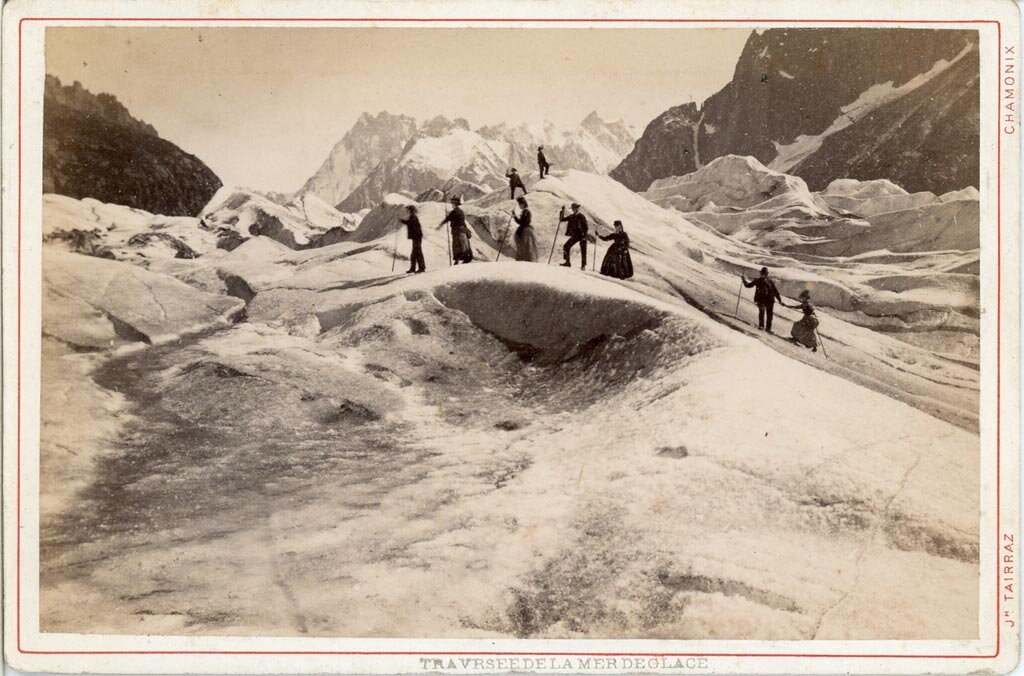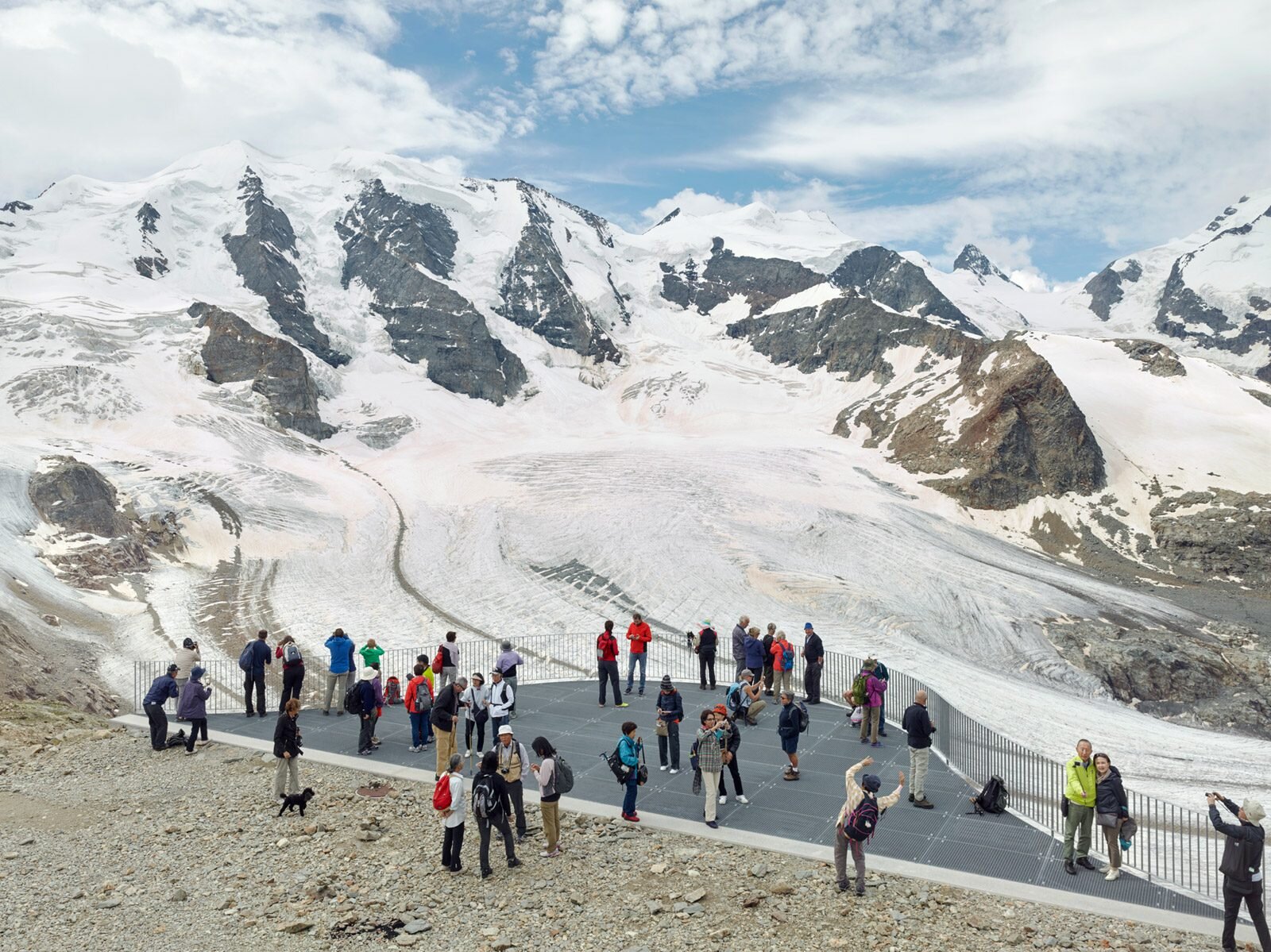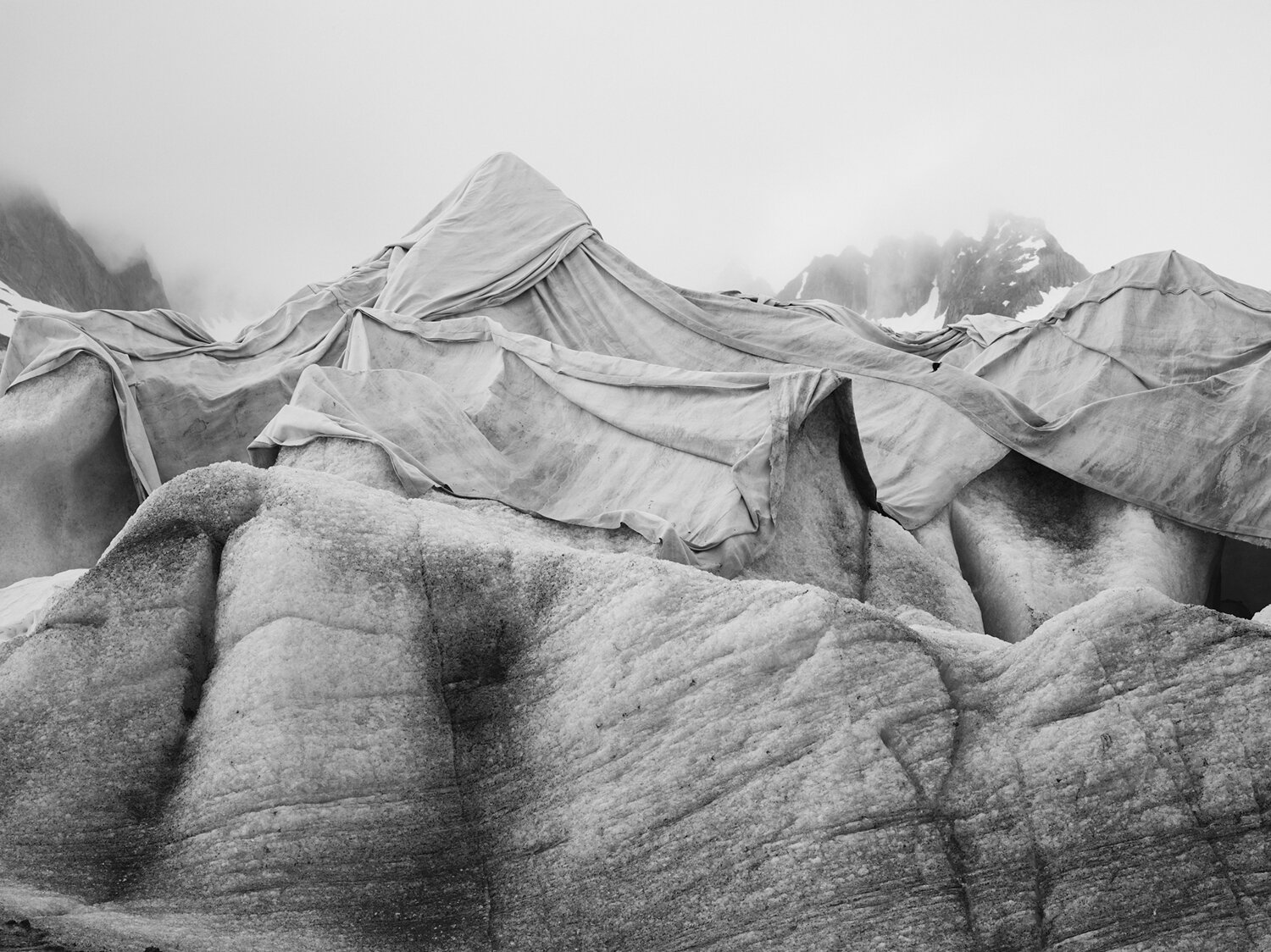Joseph Tairraz, Traversée de la Mer de Glace, c.1870
I love the nonchalance with which the climbing party seems to be strutting across the Mer de Glace. The people in this photograph would have held their poses for up to several minutes while Tairraz made the exposure, as the slight motion blur betrays. It’s a beautiful and, to contemporary viewers, quite strange image. We have no trouble relating to the activity and the motives underlying it. Alpine adventurism has grown from a fringe pursuit to a mainstream pastime since the 1870s. But the nature of the collective affectation is quite unfamiliar. Such is the artifice of it, the solemnity - as though somehow to compete with the grandeur of the mountain world around them
What’s also notable is the way the photograph signals a kind of ongoing democratisation. With the advent of photography, ordinary people could for the first time have their image immortalised. And it’s at least conceivable that the journey onto ice was made precisely for the picture. A picture which stands today as powerful testament to the entangled history of photography and Alpine tourism. What’s apparent from the visual record is that the medium played an important role in making and remaking popular perceptions of the Alps, as developments in the photographic process and shutter technology led to increasingly sophisticated and surprising ways of representing the mountains. Such representations, in turn, were instrumental to the Alps’ gradual reconceptualisation in the cultural imagination from hostile wilderness to favoured holiday destination.
For many centuries, the mountains were disdained for their chaos and desolation. Local folklore abounds with tales of dragons and malign spirits. But attitudes began to change in the second half of the nineteenth century as, spurred on by artists, philosophers and aestheticians, people developed a passion for wild places and the feeling of cosmic diminution that only they could inspire. Against the backdrop of Romanticism, photographers competed to produce ever-more spectacular panoramas from summits, outcrops and glaciers. And as their pictures diffused across the continent, the trickle of visitors to Switzerland became a tide. By the 1880s, facilitated by a growing railway network and a string of new hotels in valleys and foothills, the country was estimated to be receiving a million tourists per year.
Over the ensuing century, the Alps gradually emerged as the ‘playground of Europe’, a process which has found highest form, perhaps, in the ‘Step into the Void’ experience atop the Aiguille du Midi: a glass cube suspended above a thousand metre drop. Although this is a complex story that did not unfold through a series of neat and linear breakthroughs, its basic outline can be traced by focusing on a particular feature of the mountain landscape for which there was a craze during the 1860s: glaciers.
Something of the reverence for which mid-nineteenth century writers reserved for glaciers can be discerned from Karl Baedeker’s preface to his best-selling Handbook for Travellers to Switzerland (1863):
‘the Glacier is the most striking feature of the Alpine world, a stupendous mass of the purest azure ice. No aspect of Switzerland is so strikingly beautiful and at the same time so strangely beautiful.’
Simon Roberts, Berghaus Diavolezza #1, Bernina Massif, 2016
Jumping ahead almost one-hundred-and-fifty years to this image from Simon Roberts’ series Sight Sacralization, there is no mistaking the age of the hashtag. The Pers Glacier is an object to behold rather than to be negotiated, something to be had only in the cheapest, most fleeting sense. Clearly much has changed relative to the Tairraz: the permanent physical incursion, people’s clothes, their demeanour, not to mention the role of the photographer - one a facilitator, even participant; the other a spectator engaged in explicitly sociological work.
But in some ways Roberts’ photograph can be considered just a twenty-first century update. In both images, the glacier serves as a backdrop to a very human scene: people acting out the same basic impulse to somehow arrest the passage of time, only in ways distinct to their age. Both images provoke reflection on memory, communication, the will to conquer and control, and seen side-by-side, they testify to a profound shift.
For Ansel Adams, landscapes began at the point of human intervention - and so he always maintained his practice was not properly categorised: he was a photographer of the wild West, not of landscapes. For Adams, then, there would have been little doubt that this incongruous protrusion, a zone for selfies, negates the idea of wilderness that he and many other nineteenth-century photographers fought to protect.
John Ruskin, Frederick Crawley, Mer de Glace, Chamonix, 1854
This Daguerrotype is one of the earliest known photographs taken in the Alps. Its maker, John Ruskin, claimed to have made the first ‘sun-portrait’ of a Swiss peak, the Matterhorn, during one of his many trips to the range - where he would sketch, write and speculate on geological matters. In contrast to its quite lustrous appearance in the later Tairraz photograph, the Mer de Glace appears here as something fundamentally treacherous and unforgiving. The ice looks harsh and inflexible, almost as though made from alabaster.
William England, Mer de Glace, 1863/65
The same hulking meander is seen at a greater remove in this photograph by William England, a photographer renowned in his day but now almost forgotten. It also shows the Mer de Glace towards the end of the Little Ice Age (c.16th to 19th centuries). But where Ruskin’s image is otherworldly and defamiliarising, England’s composition brings into focus the proximity of an altogether different world: there is an interesting tension between the pastoral and the unruly.
The photograph is fairly typical of England’s style. Unlike Ruskin, he seldom ventured far from tourist paths, choosing instead to emphasise scale through deft composition. Beginning in the early 1850s, wet-collodion photographers produced much more dramatic results of mountain scenes than could be achieved with Daguerreotypes. But the process was cumbersome: each glass negative had to be sensitised on site, and then quickly developed in a portable darkroom. It was a time-consuming enterprise whose results could not be profitably mass-produced.
Joseph Tairraz, Interieur de la Grotte, c.1865
This particular problem was overcome with the rise of stereography in the later 1850s, a technique by which two slightly different photographs of the same scene were combined. When viewed simultaneously through an apparatus of lenses and prisms, an illusion of three-dimensional depth was produced. The invention was a sensation, catering to the growing demand for affordable souvenirs and enabling those who couldn’t travel to experience exotic places from the comfort of their living room. And while traditional large-format photographers needed a whole entourage of porters to carry their equipment and chemicals (as in the famous photograph by August Rosalie Bisson), stereographers could manage everything they needed single-handedly.
Without such portability, it’s unlikely Tairraz could have brought back an impression of this glacial grotto, which conveys so well the translucent quality of ice, its sheen and luminescence. The foreground arch seems almost licked with flames.
Hotel Bären, Grindelwald, c.1890-1900
The Library of Congress has acquired a huge archive of photochroms, many of which were made in the Alps. Although most depict the splendour of the wilderness, many also record the steady encroachment of tourist infrastructure. The luxurious Hotel Bären, seen here, was destroyed by fire in 1941.
Stereography fell out of fashion with the simplification of the photographic process in the 1880s and the rise of the amateur photographer. But another fad was already starting to emerge. The next development brought colour to the Alps. With the invention of photochroms in the Swiss town of Nürensdorf, the distinctive Alpine palette could be approximated and combined with an indexical representation for the first time. Produced using a complex lithographic process which built directly on the experiments of Niépce with bitumen, photochroms were also primarily intended for the tourist market. As such, they were mostly anonymous, with attribution limited to the place of manufacture; in this case, Photoglob in Zürich.
Luigi Ghirri, Alto Adige (1972-75)
Luigi Ghirri’s photograph of sightseers in South Tyrol seventy years later says much about the state of Alpine tourism without making it explicit. In a certain sense, the picture mediates between the Tairraz and the Robets. Ghirri captures his subjects candidly, from behind - they aren’t performing for camera but seem genuinely taken by the view. And yet it’s all too obvious they’ve been brought here by a coach or cable car, such is the inadequacy of their clothes for glacial traverses. We are not yet, however, at a point where it’s deemed necessary to install special observation decks.
—
Until relatively recently, glaciers seemed to all who saw like fluctuating but more or less unyielding wonders in a permanent wilderness. Their vulnerability is now all too apparent. If warming continues unabated, they are projected to have mostly disappeared from the Alps by the end of the century. Due to ice-albedo feedback, their demise will raise global temperatures even further. As much as glaciers are totemic of climate change, they are also defining features of the mountain wilderness. Once they are gone, along with most snow caps, the atmosphere of the place will be quite different. Instead of ice rivers protruding almost obscenely from misty heights into idyllic valleys, there will be a harsh and barren moraine more reminiscent of the Moon than paradise.
From Stefan Schlumpf, Hidden Landscapes
Such a future for the Alps seems increasingly unstoppable. But as Stefan Schlumpf’s series Hidden Landscape shows, authorities have not yet abandoned glaciers to their fate. At some of the most vulnerable, white blankets are now draped over the ice during summer months. With time, the folds, ridges and crevasses of the fabric become caught up in the glacier’s mostly imperceptible dynamism. And some of Schlumpf’s close-ups reveal a pleasing resonance between the topography of the ice and the material, which in turn has echoes of the peaks themselves. The series highlights in a simple but poignant way our powerlessness in the face of climate disaster. Schlumpf finds beauty in tragedy.
The Rhone Glacier, from Fabian Oefner, Timelines (2019-20)
With similar pathos, experimental photographer Fabian Oefner’s project Timelines visualises glacial retreat using the latest technology. Employing LED drones to trace out the contours of glacial footprints from previous years, the artist superimposed the results of a series of long exposures. Just as stereographs made the Alps palpable for people who were unlikely ever to visit, Oefner too seeks to make visible that which is abstract.
And it’s a fearful visualisation. The silky threads emanating from a still resilient glacier, an ice world withdrawing ineluctably into granite. But what is this image ultimately? A scientific record, a eulogy, a call to action? Work like this is often justified as raising awareness, jolting people into a deeper, more reflective form of consciousness. The magnificent work of Edward Burtynsky or Sebastião Salgado is emblematic. But since such heightened awareness usually only lasts for a short while, the degree to which this genre can go beyond pure aestheticization is dubious.
—
Like photographs, glaciers appear at first glance to be static, frozen. But as I have tried to show, their cultural meaning is always in flux, always mediated by new technologies and warped by commercial incentives. Since both the age and beauty of these places are hard to grasp conceptually, photography, from Daguerrotypes to drone flyovers, has provided a way of reaching for a certain fixity.
Almost two-hundred years have passed since the invention of the medium, an age in human history but utterly insignificant in geological time. Almost everything is now different compared to when Ruskin first stepped out onto the Mer de Glace with his wooden camera. With increasing intensity, people have dynamited passes and excavated tunnels, erected observation platforms and strung up networks of ski lifts. But for the mountains, there is basically complete continuity.
And yet while the idea of deep time is evasive, and impossible to convey, in itself, in a photograph, what can be discerned quite clearly from the juxtaposition of images stretching back to the medium’s origin is an ongoing domestication of the Alps whose final destination is always deferred, always just beyond the horizon.







